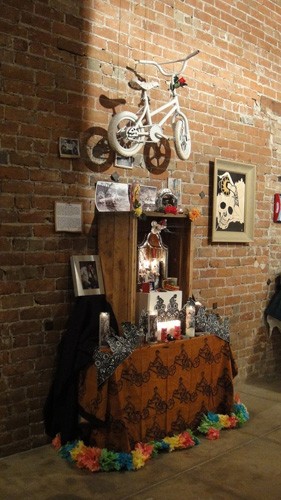In the midst of Arizona’s current state of political upheaval, Raices Taller 222 Art Gallery and Work Shop is not afraid of controversy. With its most recent show featuring art inspired by the now-infamous Arizona immigration law SB 1070, Raices Taller is promoted as “”Tucson’s only Latino-based nonprofit cooperative contemporary art gallery and workshop.””
Raices Taller, which translates to “”roots workshop”” in Spanish, was formed 13 years ago, according to John Salgado, the president of the gallery.
“”The gallery started out as a core group of artists, young and old, who got together originally because they didn’t have access to any of the (for-profit) exhibitions around town.
The attitude of the galleries was: ‘We don’t show Latino art — it’s too colorful, too folksy, too political, too cutesy,'”” Salgado said.
The aspiring group of artists then started meeting in each others’ homes, which later became some of the places shows were first held before they got their own space, Salgado said. Today, the shop sit just west of campus, near the corner of Sixth Avenue and Sixth Street.
“”Unexpectedly, the gallery has become a center of the Arizona arts community,”” Salgado said.
Raices doesn’t limit its exhibits to only Latino art, however.
After forming the space, Raices soon started workshops for youth or aspiring artists, many taught by established artists.
“”People would say, ‘I’ve always wanted to paint, to be an artist,’ or, ‘My teenage son or daughter wants to paint but I can’t afford to send him (or) her to art school,'”” Salgado said.
Raices’ most recent show was organized as a political statement to highlight the societal implications of SB1070. In the wake of the bill’s passage in late April, an emergency meeting of the cooperative members was called in which they collectively decided to have a show inspired by the political climate that surrounded the bill. Raices named the show show “”How Brown Am I”” with a label on every piece of art reading, “”Warning: This Artist May Be Illegal.””
Parts of the show stirred controversy, Salgado said. One of the pieces, by artist Cake MacKinnon, was made out of an Arizona flag with a yellow cloth Star of David with the word “”Jude”” in the middle sewn over the flag’s gold star and autographed by many Latin American youth. The star is similar to those mandated to be worn by Jews living in Nazi Germany and occupied Europe during World War II.
Critics called the piece extreme and inaccurate with regard to SB 1070.
MacKinnon herself explained her intentions in a written statement accompanying the piece, which read, “”I wanted to hand stitch my own Star of David, which the Jewish people had to wear during World War II. Doing this, I felt a sense of dread, mixed with pride, actually. A strange sensation … to be proud of a people’s heritage, but to be made to submit to scrutiny because of it.””
However, MacKinnon’s piece did not account for the only criticism the gallery received. Salgado said Raices received e-mails that suggesting the gallery was supporting illegal immigrants by having the show. Salgado suggested that artists have a role like that of news reporters.
“”Artists are the ones that spread the word. They got their finger on the pulse of what’s going on,”” he said.
Salgado also points to a social responsibility that he believes artists have.
“”Picasso did ‘Guernica,'”” he said. “”What a political statement … It’s a statement using paint. It becomes politically important. That’s the artist’s role.””









